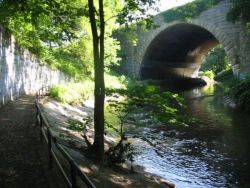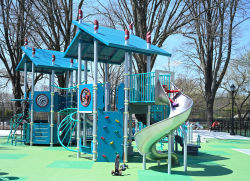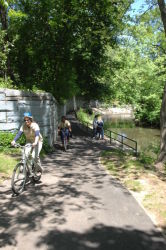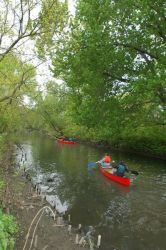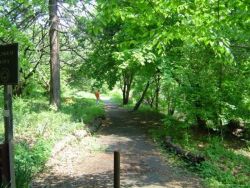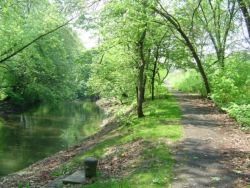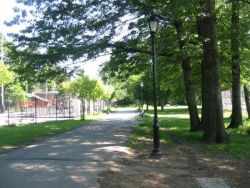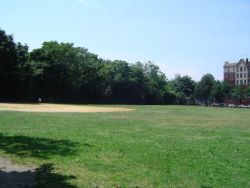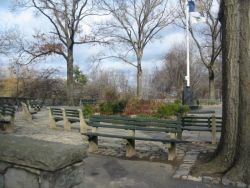Bronx Park
The Daily Plant : Tuesday, July 10, 2001
TIME CAPSULE IS OPENED IN THE ARSENAL GALLERY
This March, in the midst of conservation, the base of the Bronx Victory Memorial in Pelham Bay Park yielded a wonderful surprise-a time capsule we never knew existed. It contained yellowed newspapers and the WWI medals of Bronx soldiers. The capsule was dated 1932. How does one celebrate such a discovery? A new exhibit in the Arsenal Gallery Greener Pastures: A History of Bronx Parks is one response.
The exhibit opened Wednesday, June 27, 2001 with a party catered by Bronx eateries. Amici's, G-bar, Feeding Tree Restaurant, The Black Whale, and Tosca fed the more than 200 guests in attendance. Each of those restaurants will be featured in the Bronx Tourism Council's forthcoming publication, Where to Eat in the Bronx. Doris Quinones of the Bronx Tourism Council addressed the visitors as did Commissioner Henry J. (StarQuest) Stern; William (Zorro) Castro, Bronx Borough Commissioner; and Jonathan (Archive) Kuhn, Director of Art and Antiquities and curator of the exhibit. Among the guests were Lloyd Ultan, Bronx Borough Historian; Susan Nichols, Executive Director of Save Outdoor Sculpture; and Adrian (Sassafras) Sas, Public Art Coordinator.
The exhibit dips into the vast resources of Parks' archives, and encapsulates choice moments, choice parks, and choice views. Some of Parks' creative efforts to collaborate with community members are taking place in the Bronx. An ambitious effort to restore the Bronx River is underway with the participation of hundreds of community organizations and support from federal, state, and city government. Crotona Park was named a Catalyst site by Partnerships for Parks. Neighbors of the park participate in events from design workshops to family carnivals. As an introductory text by Jonathan Kuhn makes clear, what may feel like an unprecedented groundswell in Bronx parks reaches back in the history of the system. Below is that text in full.
GREENER PASTURES:
A HISTORY OF BRONX PARKS, 1888-2001
The Bronx parks system is both a success story and a work in progress. In the 1870s the area that is now New York City's northernmost borough was a sparsely populated terrain of varied topography and much natural beauty, known as the 23rd and 24th Wards and including part of lower Westchester County. Early in the decade esteemed landscape architect Frederick Law Olmsted helped design a network of parks and parkways to conform to the existing features, but his plan was never realized.
In 1881, journalist and reformer John Mullaly also recognized the scenic potential
and "marked [natural] diversity" of this region, far beyond its few
scattered parks and village greens. Anticipating further annexation and massive
population growth, he formed the city's first open-space advocacy organization,
the New York Park Association. The Association argued that nearly 4,000 acres
above the Harlem River should be seized immediately as parkland, since they
required little improvement and their acquisition would dramatically increase
the value of adjacent properties. The Association helped secure State legislation
in 1883 to establish six large parks and three broad parkways. Political wrangling
slowed the process, but on December 12, 1888, Bronx, Claremont, Crotona, St.
Mary's, Van Cortlandt and Pelham Bay Parks, as well as Crotona, Mosholu and
Bronx-Pelham Parkways, were vested to the City of New York. These new holdings
quintupled the City's green space overnight.
Resources were scarce at first, but in the 1890s the now-famous zoo and botanical
garden were chartered in Bronx Park, and the nation's first municipal golf course
opened at Van Cortlandt Park. By 1902 the city had acquired St. James, Poe,
Cedar, Rose Hill and Echo Parks; historic Drake Cemetery was incorporated in
1909 and the Seton estate ceded to the City in 1914. Macombs Dam Park opened
in 1899, with tennis courts, baseball fields and a track, and eight Bronx playgrounds
were built in 1914.
Starting in 1934, Parks Commissioner Robert Moses directed a major overhaul and expansion of the Bronx parks. In his first six years he tripled the number of playgrounds in the borough. In 1936 the man-made crescent-shaped Orchard Beach opened, as did the mammoth pool at Crotona Park. In 1951, St. Mary's Park became home to the City's first post-war recreation center. Soundview and Ferry Point Park rose upon landfill. The new Henry Hudson Parkway (1938) and Major Deegan Expressway (1955) linked parks but, alas, also bisected them.
In the late 1960s, with greater community input, pools and vest pocket parks were built where needed, and parks programming embraced the contemporary arts scene and a broader ethnic mix. Today more than 130 dedicated citizens organizations have formed partnerships with government to revive long-neglected amenities like the Bronx River, and to reinvigorate local parks, playgrounds and community gardens. Parks' own efforts have included wetlands preservation, reforestation and species reintroduction.
Though the borough has long been saddled with a reputation for urban decay, the reality is that a full quarter of its acreage is parkland, much of it bucolic, and filled with unique attractions from Edgar Allen Poe's last home and the lavishly carved Heinrich Heine Fountain to legendary Yankee Stadium. The foresight of park proponents such as Mullaly helped ensure that the borough, whose population is now more than 15 times what it was in 1888, would truly be a land of greener pastures.
By Jonathan (Archive) Kuhn
THIRTEEN YEARS AGO IN THE PLANT
(Tuesday, July 12, 1988)
PARKS HIRED ARMY OF SUMMER WORKERS
Parks hired over 3,300 seasonal workers to staff beaches and pools and to assist with cultural activities and general maintenance during the agency's busiest season.
Although the workers are seasonal, hiring and processing them is a year-round task for Maria Oliveras, Chief of the Seasonal Hiring Unity, and her staff. Each year the Hiring Unit decides how many seasonal employees Parks needs, and when they should be hired. Letters are sent to prospects on a "Seniority List"-people who have worked for the agency in past summers and have performed well.
QUOTATION FOR THE DAY
"I'm going out to clean the pasture spring;
I'll only stop to rake the leaves away
(And wait to watch the water clear, I may):
I shan't be gone long. -You come too.
Robert Frost (1874-1963)
Check out your park's Vital Signs
Clean & Safe
Green & Resilient
Empowered & Engaged Users
Share your feedback or learn more about how this park is part of a
Vital Park System

